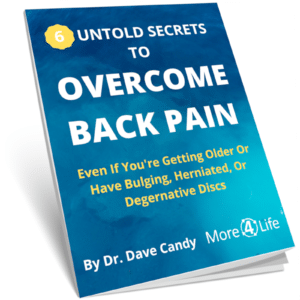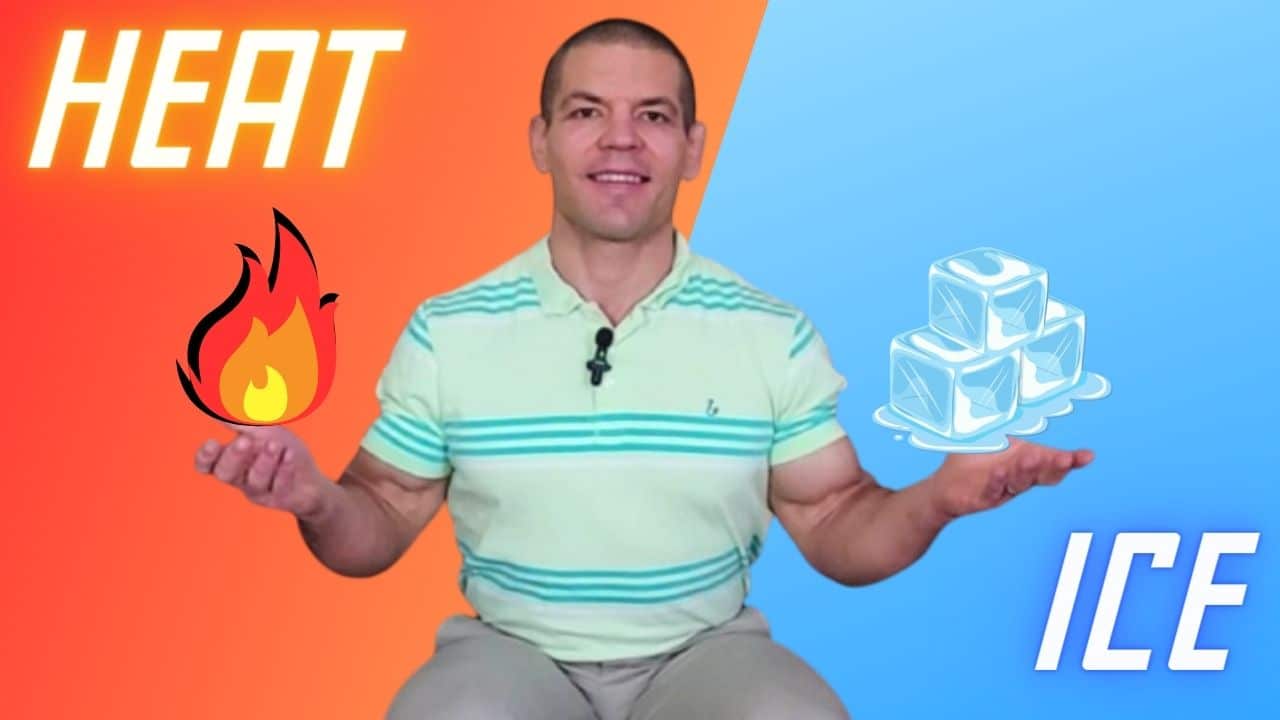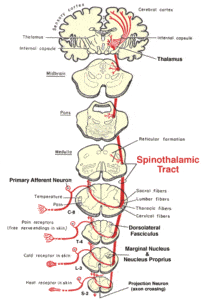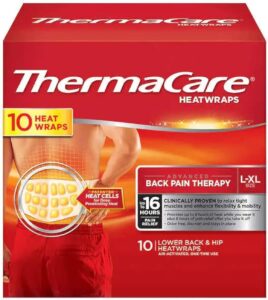Should I Use Heat or Ice for Low Back Pain?
As a physical therapist, that's one of the most common questions I get from patients.
The answer I give is:
It really doesn't matter; use whichever one feels best for you.
But if you want my recommendation, use heat.
Watch the video below to learn why, plus what research says about heat and ice for low back pain.

Conventional Wisdom for Ice or Heat Doesn't Apply To Low Back Pain
The conventional wisdom for ice versus heat is to use ice for the first 24 to 48 hours and then use heat after that.
But that's largely based on thought processes for more superficial joints like knees or ankles, where the tissues are close to the surface of the body.
If you have an acute injury, such as an ankle sprain, where you roll your ankle, you get bruising and swelling.
The benefits of ice in that situation are that it causes vasoconstriction, or it causes your blood vessels to constrict. If you've torn blood vessels, that decreases how much blood you lose.
Furthermore, it decreases the metabolism of your tissues. If they're not getting blood flow and not getting nutrients and oxygen, it decreases their energy demands so that you limit cell death while your blood vessels are healing.
However, for low back pain, usually there's not an acute "injury" per se that causes bleeding and swelling.
Furthermore, since the tissues are deeper, superficial ice or heat really aren't going to have those effects.
The maximum penetration of superficial ice or heat is about 0.5 centimeter or about 1/5 of an inch.
In the lower back area, that's often not deep enough even to get through the skin layer, let alone down to the deep muscles, vertebrae, and discs.
Therefore, the effect of heat or ice for low back pain has less to do with actual tissue healing and more to do with the neurological signaling processing of pain.
Effects of Heat or Ice for Low Back Pain
Both ice and heat activate thermal receptors.
Collectively, these receptors are known as transient receptor potential membrane channels or TRP receptors for short.
Heat activates the TRPV1 receptor and ice or cold activates the TRPM8 receptor.
Is Ice Good For Lower Back Pain?
Ice causes a slowing down of nerve conduction, so it basically decreases how fast the signal from your tissues gets up to your brain.
Physiologically, it doesn't really get deep enough to stop inflammation in the lower back, so it's benefits are mainly in terms of pain control.
Is It Good To Put Heat On Lower Back Pain?
Heat, on the other hand, activates the TRPV1 receptor (Transient Receptor Potential Vanilloid 1).
TRPV1 sends a signal along your spinal cord, along the spinothalamic tract, which carries information both about temperature as well as nociception (painful sensations).
When that signal hits your brain, it triggers your brain to release opioid-like chemicals such as endorphins.
Those both block further nociceptive signals from getting up to your brain as well as makes your brain not care about those signals so much. So the nociceptive signals that reach the brain aren't perceived as a threat.
This in turn can decrease muscle spasm, and muscle spasm can trigger further pain.
So using heat breaks up the pain-spasm cycle in your lower back muscles and helps decrease the transition of acute pain to chronic pain.
It also decreases pain enough that you can move and be more active, which has been shown to decrease back pain over the long term.
How Long To Use Heat or Ice For Low Back Pain?
Conventional wisdom says you should use heat or ice about 15 to 20 minutes.
While that may be sufficient for cold therapy, according to research, that's probably massively underdosing for heat therapy.
Research On Heat For Lower Back Pain
Most of the research on superficial heat studies low-level continuous heat wraps, usually worn for 8 hours. These have been shown to be very effective for lower back pain.
Heat wraps have been shown to be more effective than both ibuprofen and acetaminophen.
They've also been shown to increase trunk lateral flexion flexibility and improve function.
Furthermore, the combination of low-level heat wraps combined with exercise has been shown to be more effective than either one of those alone.
Heat or Ice for Low Back Pain According To Research
A systematic review of studies on ice and heat found only 2 low-level studies comparing heat packs vs. ice massage for low back pain. One showed no difference and the other showed that ice massage was more effective than heat packs for chronic low back pain. Neither of these studies was a randomized controlled trial.
Heat Products For Low Back Pain
Thermacare Back Pain Heat Wraps
The low-level continuous heat wrap used in most of the research studies is the Thermacare back pain heat wrap.
It should be noted that some of those studies were funded by Procter & Gamble, the company that originally produced Thermacare.
Thermacare has since been sold to other companies, but there is a small risk of bias when the company that produces the product funds the research.
However, there have been enough research studies showing the effects of low-level continuous heat and the side effects are fairly minimal.
Thermacare Heatwraps Lower Back & Hip, L...
40% OffFor most people, the side effects are some rash or skin pinkness.
You have to be careful with any type of heat product that you don't cause burns. This is especially true if you have decreased sensation in your skin.
Bob & Brad Wearable Heating Blanket
Now, if you don't want to use Thermacare wraps because they're disposable, an alternative would be using a wearable heating pad such as the Bob and Brad weighted heating pad.
BOB AND BRAD Weighted Heating Pad for Ba...
$47.99 ($47.99 / Count) (as of May 19, 2024 09:20 GMT -05:00 - More infoProduct prices and availability are accurate as of the date/time indicated and are subject to change. Any price and availability information displayed on [relevant Amazon Site(s), as applicable] at the time of purchase will apply to the purchase of this product.)Promo Code: BobBrad67
This heating pad covers a large surface area. It ties around your waist so you can actually get a little bit of compression, much like a disposable heat wrap.
Furthermore, you can wear it for up to two hours before it shuts off. And then you can just reset it several times if you want to have that eight-hour continuous period.
The heat level is adjustable so that you can use a lower heat and avoid burn.
The downside is that you do have to be plugged in to use this.
Therefore, this heating pad might be good for someone who works in an office where you have easy access to a plug.
If you're someone who's more on the go and you have more of an active physical job, you may be better off with a Thermacare wrap.
Heating and Cooling Creams and Gels
Heating and cooling creams, gels, and rubs can be helpful for lower back pain, but they're usually only for symptomatic relief.
They don't really "heal" anything.
The heating gels and creams tend to have an active ingredient like capsaicin.
RUGBY LABORATORIES Capsaicin 0.025% Crea...
36% OffCapsaicin activates the TRPV1 receptor just like heat.
On the other hand, cooling gels such as Biofreeze that have menthol as an active ingredient.
Biofreeze Pain Relief Roll-On 2.5 FL OZ,...
$34.99 (as of May 19, 2024 09:20 GMT -05:00 - More infoProduct prices and availability are accurate as of the date/time indicated and are subject to change. Any price and availability information displayed on [relevant Amazon Site(s), as applicable] at the time of purchase will apply to the purchase of this product.)Menthol activates the TRPM8 receptor, similar to ice.
Again, heating and cooling gels really just offer symptomatic relief.
However, if this allows you to move more and be more active, doing those things will help you:
- decrease your pain over the long-term
- return to a more active lifestyle
- prevent the neurological transition from acute pain to chronic pain
Conclusion
Although heat and ice can both offer relief from lower back pain, neither will address the underlying root cause that caused the pain in the first place.
The penetration depth of ice and heat are very superficial, so they are probably not actually causing any tissue healing.
Furthermore, unless you've had a traumatic back injury such as a car accident, most back injuries are due to cumulative microtrauma over time.
This means that there's usually not one big injury, but little tiny micro-injuries that build up over time.
These usually develop as a result of repeated movements or sustained postures.
If you don't address those things, then neither ice nor heat will help over the long term because you're just going to keep re-aggravating your back.
Want A Lasting Solution For Low Back Pain?
If you'd like to find the root cause of your low back pain and find a long-term solution for it, we'd be happy to help you.
Just tap the button below to request an appointment with one of our specialist physical therapists.








